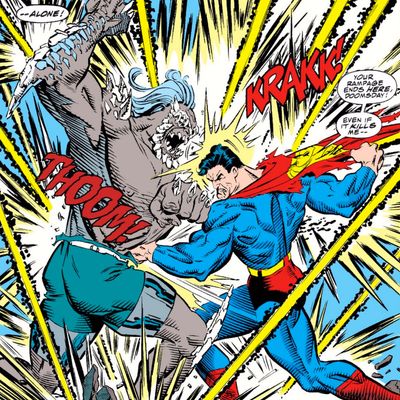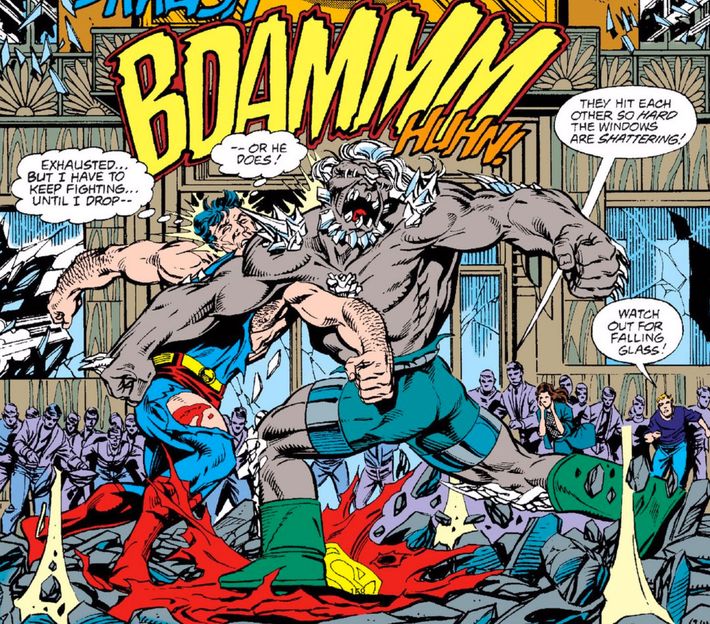
Sure, Batman and Superman fight in Batman v Superman: Dawn of Justice. But their fight isn’t the movie’s biggest fight. That honor goes to the mammoth tussle that both of the title characters (as well as the all-too-briefly featured Wonder Woman) engage in with a snarling behemoth who can’t be killed by conventional means. Anyone familiar with early-’90s DC comics will recognize this creature instantly: it’s Doomsday, the beast that killed Superman in 1992’s best-selling “Death of Superman” story line. Even though the character has had a major impact on popular culture, his real-world origin story is charmingly haphazard, according to new interviews Vulture did with his creators.
In the early ‘90s, there were four monthly comics series starring Superman — Superman, Action Comics, The Adventures of Superman, and Superman: The Man of Steel — and though each series had its own creative team, they regularly engaged in crossovers between all four titles. In order to wrangle this potentially chaotic system, the creators would meet up annually for what they called the “Super Summit.” There, they would plan out the next few months’ worth of stories.
Their 1992 meeting was a uniquely frustrating one. The assembled creators wanted to do a big event in which Clark Kent finally married longtime love interest Lois Lane, but the sinister forces of cross-platform synergy stopped them. They were informed that a new TV series was on the way: ABC’s Lois & Clark: The New Adventures of Superman, in which Lois and Clark would be in their classic will-they-or-won’t-they romantic limbo. It wouldn’t technically exist in comics continuity, but in order to keep the Superman brand consistent onscreen and off, the higher-ups didn’t want the couple to be wed on the printed page.
“We were told we had to come up with something at the last minute,” recalls The Man of Steel writer Louise Simonson. There was a running gag at Super Summits: When the creators were hitting a wall, Adventures of Superman writer Jerry Ordway would propose killing Supes. Previously, it had never been taken seriously. But in Simonson’s recollection, this time the desperate brain trust was game for the outlandish notion: “Jerry said, ‘Let’s kill him.’ And we said, ‘Great!’”
But how would they knock off a nigh-invincible man who’d survived all manner of threats since his 1938 debut? They’d need a villain to do the deed. By coincidence, Superman writer–artist Dan Jurgens had been kicking around a separate, simple story idea: “monster rips apart Metropolis,” as he describes it now. The group opted to combine the death with the monster. It would represent a change of pace from the more cerebral villainy that had populated the Superman books in recent years. “At that time, Lex Luthor was a businessman, Brainiac was more or less non-powered, and villains like Toyman and Prankster had no powers,” says Jurgens. “I just wanted to draw a knock-down, drag-out fight.”
The name came by accident. While brainstorming, they’d written “Doomsday for Superman” on a whiteboard, and they eventually thought it might be cool to just have the villain’s moniker be Doomsday. He also needed a distinctive look. So a challenge was put forth: All the artists in the room would get a few minutes to scribble designs on paper, then everyone would vote on the design they liked the best. Jurgens — who says he still has the yellow legal pad on which he did his quick sketch — was the victor. His vision was a hulking humanoid creature with massive muscles and chunks of bone jutting out from various parts of his skin.
The group aimed to roll Doomsday out to the world in a fresh, exciting, and mysterious way. “My idea was that it should be something that was big and horrible and a mystery,” says Simonson. “We wouldn’t know what its origin was. This thing would burst out and start pounding Superman.” Indeed, Jurgens says the creative team at the summit didn’t even bother to figure out an origin story. Much more important was the surprising way he would actually kill the Man of Steel: not by exploiting the usual Super-weaknesses like Kryptonite or light from a red sun, but instead by sheer force. Doomsday would, in essence, just punch him to death. That way, they’d catch readers off-guard: “If you ‘know’ what can harm Superman — and what can’t — there’s not much surprise,” Simonson says. “We wanted to do something unexpected.”
There was something else they didn’t want readers to expect: that this death was never intended to last. “Of course it wouldn’t be permanent! Superman’s a character with a lot of advertising revenue tied to him,” Simonson says. “I felt kinda guilty that people would think we had really killed him permanently, but we had to sign nondisclosure agreements saying we couldn’t talk about it. We couldn’t reassure people that he was coming back.”
Along those lines, DC delighted in slightly misleading the public. In the fall of 1992, they aggressively promoted the upcoming death story. They had financial incentives to do so. It was a time when the comics industry was in the midst of a speculators’ bubble: For various reasons, comics had become a collectors’ item, with publishers designating certain issues as especially significant and consumers subsequently selling mint-condition copies of those issues for many times their face value. Retailers therefore ordered massive numbers of copies of Superman No. 75, in which the demise was scheduled to occur. Mainstream TV and print news outlets reported on the story credulously, making non-geeks prick up their ears, too. This was the end of an American icon, after all.
But there had to be a story leading up to it, and the creative teams delivered a yarn that remains exciting to this day. Our first glimpse of Doomsday comes in The Man of Steel No. 17, written by Simonson and penciled by Jon Bogdanove, and it’s as mysterious as it is brutal. After an entirely unrelated story, there’s a one-page epilogue. A narration box in the top-left reads, “Somewhere else … ” and there are three panels below it showing massive fists, clad in green gloves, punching some kind of metal surface. “KRAANG!” is the sound effect of impact, its letters getting bigger and bigger with each panel. The final panel appears to show the other side of the surface, where the “KRAANG!” is much smaller, but still apparent. Another narration box appears in the bottom-right: “… Doomsday is coming!”
In the following issue of The Man of Steel, the creature breaks free of its metal prison. Upon emerging, we see he’s encased in a strange, turquoise jumpsuit with red goggles. A tiny bird alights on his hand and he crushes it in his fist with a sickening “BLORCH.” He laughs. For the next few issues of the Superman titles, this beast marched a path of destruction across America. Superman and superhero squad the Justice League show up to try and stop him, but their efforts are for naught. Gradually, his jumpsuit rips off, revealing a grey-skinned monster with inhuman bone-growths protruding from his body and murder in his eyes. “I’m telling you right now — it’s like Doomsday is here!” says hero Booster Gold, leading Superman and the press to name the force of destruction accordingly.
Doomsday plows his way toward Metropolis, growling and laughing rather than delivering supervillain monologues — or even basic conversation. Superman feels an increasing sense of panic. “This is … insane!” he thinks to himself while getting clobbered. “I’d swear … the harder I fight … the more Doomsday likes it!”
The creators had a clever and subtle strategy to increase the bombast of the story: For its final four installments, each issue would have a decreasing number of panels per page. That way, the images would get bigger and bigger as the story built to the end. The pages in Adventures of Superman No. 497 had four panels each, the next episode had three, the next had two, and the climactic issue — Superman No. 75 — consisted entirely of massive, single-panel images from Dan Jurgens that filled the whole page. An exhausted Superman kisses Lois and tells her he’ll always love her, then leaps into a final clash.

“Like weary boxers who have gone the distance, the combatants collide in one last, explosive effort,” the narration reads. “In the years to come, a few witnesses will tell of the power of these final punches … that they could literally feel the shockwaves. Others will remember the enormous crater that resulted from the sheer force of the blows. But most will remember this sad day — as the day the proudest, most noble man they ever knew — finally fell.” Using all his strength, Supes kills Doomsday (one of the few times he ever broke his no-kill rule), but it’s his last act. Lois cradles the love of her life as he breathes his last.
Of course, through complicated sci-fi shenanigans, Superman came back just a few months later, as did Doomsday. But the mainstream publicity and titanic brutality of the story allowed it to pass into myth — and brought Doomsday with it. The character has popped up numerous times in the ensuing decades to terrorize the Man of Steel. A 1995 tale written and drawn by Jurgens, Superman/Doomsday: Hunter/Prey revealed that Doomsday was actually an ancient Kryptonian creature. That aspect is somewhat echoed in Batman v Superman, but the main carryover between the comic-book and cinematic representations has nothing to do with Doomsday’s origin story. In the movie, as in the original story line, he is defined primarily by his strength, endurance, and dearth of dialogue. Superman’s other famous foes all have gimmicks; Doomsday is frightening because he has none. He is and always has been violence incarnate.
“Doomsday was simple and pure, the way many of the best ideas are,” says Bogdanove. “He had no complications to get in the way of Superman’s final thesis — he was just elemental Fate.”

